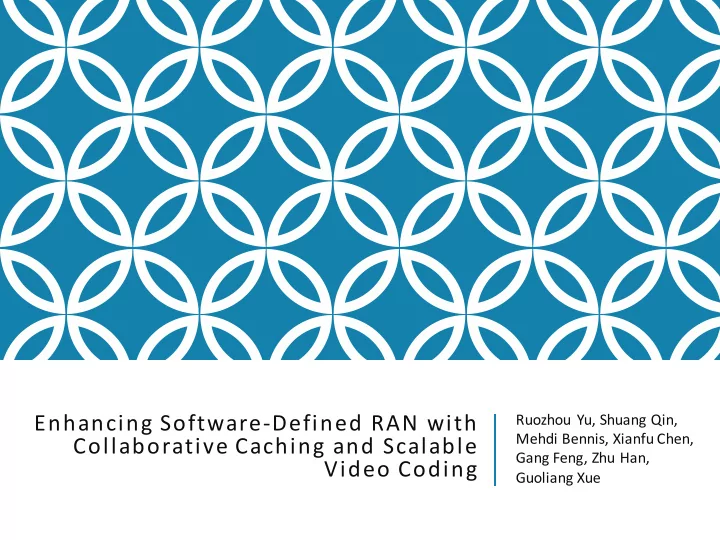

Enhancing Software-Defined RAN with Ruozhou Yu, Shuang Qin, Mehdi Bennis, Xianfu Chen, Collaborative Caching and Scalable Gang Feng, Zhu Han, Video Coding Guoliang Xue
Agenda Introduction Problem Formulation Solution Design Performance Evaluation Conclusions 2
Software-Defined RAN Decoupled control & data planes. Control Plane Centrally managed resources and info. Data Plane Opportunity for inter-BS collaboration. Global optimization for content delivery Channel Info Radio Traffic Resource Requests Storage User Resource Preferences Backhaul …… Bandwidth …… 3
Video Caching in RAN Video 1 request Video 2 request Video 3 request 4
Video Caching in RAN Video 1 request Video 2 request Video 3 request 5
Collaborative Caching Video 1 request Video 2 request Video 3 request 6
Scalable Video Coding (SVC) Videos have different bitrate versions: 360p, 720p, 1080p, etc. SVC slices video into different layers: Base layer guarantees the minimum bitrate playback Each enhancement layer increases bitrate by one level Enh. BR 4 Enh. BR 2 Base BR Base Layer Layering Constraint: to get enhanced BR l , both the base layer Enh. Layer 1 Enh. Layer 2 Enh. Layer 3 Enh. Layer 4 Enh. Layer 5 and all enhancement layers below l are needed. Enh. BR 1 Enh. BR 3 Enh. BR 5 7
Agenda Introduction Problem Formulation Solution Design Performance Evaluation Conclusions 8
Problem Overview Generally,given the network status and some prediction on user’s video requests, we want to decide two things: 1) which base station’s cache stores which layers of which video, and 2) how to schedule (route) the video streams of each request, such that we maximize the number and qualityofvideos served, meanwhile minimizingthe delayreceived by users. 9
Network Model Base stations B ={ B 0 , …, B M } Cache size c i Upstream/downstream backhaul bandwidth b iu / b id B 0 denotes the Internet with unlimited cache and bandwidth Distance between two BSs d i, ɩ Videos V ={ V 1 , ..., V N } Layers L j = {1, ..., L j } for each video V j Layer size s jl Layer bandwidth requirement β jl ψ ɩ j,l : number of users at BS B ɩ , requesting the first l layers of video V j 10
Variables x ij,l : indicator ofcaching video V j ’s layer l at BS B i z i, ɩ j,l : number of video V j ’s layer l requested byusers from BS B ɩ and served by the cache of BS B i 11
Objectives r j,lb : unit reward for serving video V j ’s layer l to user; c jd : unit cost for incurring delayfor video V j Objective: d ɩ j : aggregated delay received by video V j ’s user(s) at BS B ɩ 12
Constraints 13
Constraints cont. 14
Agenda Introduction Problem Formulation Solution Design Performance Evaluation Conclusions 15
Algorithm Overview Two stages: Stage 1: decide the caching of videos (layers) at each base station; Stage 2: decide which base station serves each layer of each user’s request, based on the Stage 1 results. Rounding-based algorithm: Relax the ILP formulation to LP; Solve for a (fractional) solution; Use deterministic rounding technique to obtain an integral solution. 16
Stage 1: Video Caching Form ILP formulation and get LP relaxation Solve LP and obtain fractional solution Compute each variable x ’s contribution towards objective Greedily round the caching variable x in sorted order Output caching decisions 17
Stage 2: Video Scheduling Form LP with fixed caching variables x Solve LP and obtain fractional solution Round down each scheduling variable z to obtain a basic solution Schedule more requests More can be via backhaul scheduled? YES NO Output scheduling decisions 18
Agenda Introduction Problem Formulation Solution Design Performance Evaluation Conclusions 19
Setup Randomlygenerated RAN environment: 15 BSs 10000 users uniformly distributed 5000 videos with Zipf popularity distribution: ɣ=0.95 5 layers per video: 10% coding overhead introduced Randomly generated cache, video size and bandwidth capacity/demands Five schemes for comparison: SC: SVC + Collaborative caching SS: SVC + Single BS caching NC: Non-SVC + Collaborative caching NS: Non-SVC + Single BS caching NN: Non-SVC + No caching 20
Exp. With Default Parameters 21
Active Users 22
Average Layers (Bitrates) 23
Average Delay 24
Agenda Introduction Problem Formulation Solution Design Performance Evaluation Conclusions 25
Conclusions Enhancingvideo deliveryin software-defined RAN with collaborative caching and SVC. Collaborative caching to reduce user delay; SVC to increase cache reuse and serve more users. Maximizingrewards and minimizingdelay:a joint problem. NP-hard 2-stage rounding-based algorithm. Decide caching first. Schedule videos based on caching. Outperforms usingeither collaborative cachingor SVC alone. 26
Thank You Q&A 27
Recommend
More recommend